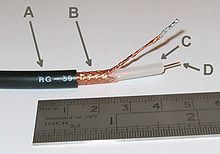RG-59

A: outer plastic sheath
B: copper braid shield
C: inner dielectric insulator
D: copper-plated core
RG-59/U is a specific type of coaxial cable, often used for low-power video and RF signal connections. The cable has a characteristic impedance of 75 ohms. The 75 ohm impedance matches a dipole antenna in free space. "RG" was originally a unit indicator for bulk radio frequency (RF) cable in the U.S. military's Joint Electronics Type Designation System. The suffix "/U" means “for general utility use.” The number "59" was assigned sequentially. The "RG" unit indicator is no longer part of the JETDS system (MIL-STD-196E) and cable sold today under the RG-59 label does not necessarily meet military specifications.
RG-59 is often used at baseband video frequencies, such as composite video. It may also be used for broadcast frequencies, but its high-frequency losses are too high to allow its use over long distances; in these applications, RG-6 or RG-11 is used instead. In cases where the transmission distance is too long for these media, such options as UTP (unshielded twisted pair) or fiber optic can be used. However, UTP such as CAT6 has too many twists in the twisted pairs which result as a poor choice of media for analog signals over long distances; the preferred medium is fiber optic cable.
RG-59 coaxial cable is commonly packed with consumer equipment, such as VCRs or digital cable/satellite receivers. Manufacturers tend to include only RG-59 cables because it costs less than RG-6 does. However, given the short lengths provided (usually 4-6 feet / 1.2-1.8 m), this is generally sufficient for its typical use.
RG-59 is frequently used to synchronize two digital audio devices, such as ADAT optical devices. This is called word clock.
Better breakdown characteristics allows for high voltage use in scientific experiments.
See also
- BNC connector
- Coaxial cable
- RG-58 — A similar cable but with an impedance of 50 or 52 ohms
